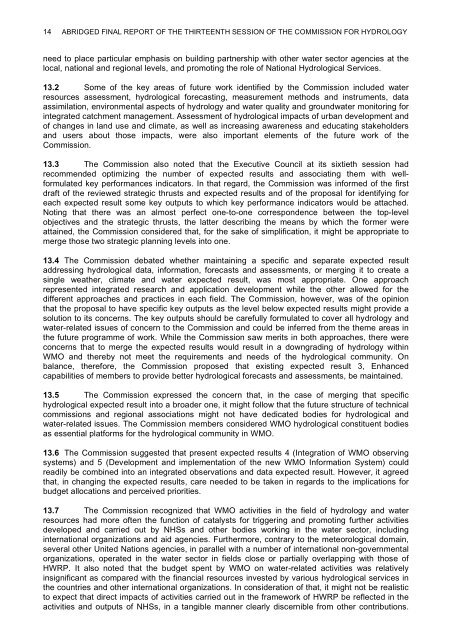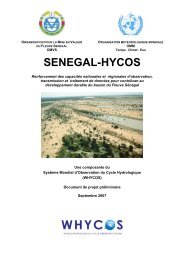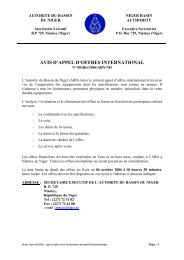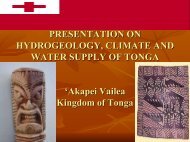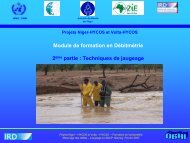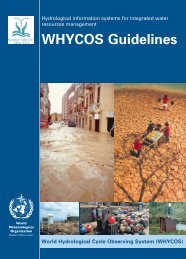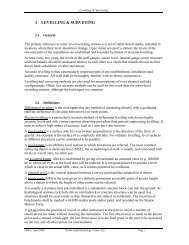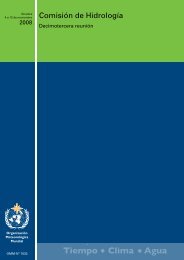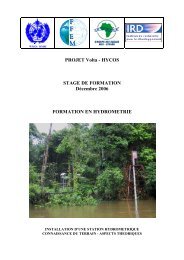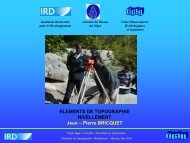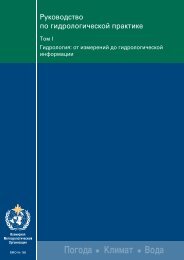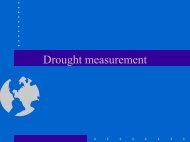Part I - FTP Directory Listing - WMO
Part I - FTP Directory Listing - WMO
Part I - FTP Directory Listing - WMO
Create successful ePaper yourself
Turn your PDF publications into a flip-book with our unique Google optimized e-Paper software.
14 ABRIDGED FINAL REPORT OF THE THIRTEENTH SESSION OF THE COMMISSION FOR HYDROLOGYneed to place particular emphasis on building partnership with other water sector agencies at thelocal, national and regional levels, and promoting the role of National Hydrological Services.13.2 Some of the key areas of future work identified by the Commission included waterresources assessment, hydrological forecasting, measurement methods and instruments, dataassimilation, environmental aspects of hydrology and water quality and groundwater monitoring forintegrated catchment management. Assessment of hydrological impacts of urban development andof changes in land use and climate, as well as increasing awareness and educating stakeholdersand users about those impacts, were also important elements of the future work of theCommission.13.3 The Commission also noted that the Executive Council at its sixtieth session hadrecommended optimizing the number of expected results and associating them with wellformulatedkey performances indicators. In that regard, the Commission was informed of the firstdraft of the reviewed strategic thrusts and expected results and of the proposal for identifying foreach expected result some key outputs to which key performance indicators would be attached.Noting that there was an almost perfect one-to-one correspondence between the top-levelobjectives and the strategic thrusts, the latter describing the means by which the former wereattained, the Commission considered that, for the sake of simplification, it might be appropriate tomerge those two strategic planning levels into one.13.4 The Commission debated whether maintaining a specific and separate expected resultaddressing hydrological data, information, forecasts and assessments, or merging it to create asingle weather, climate and water expected result, was most appropriate. One approachrepresented integrated research and application development while the other allowed for thedifferent approaches and practices in each field. The Commission, however, was of the opinionthat the proposal to have specific key outputs as the level below expected results might provide asolution to its concerns. The key outputs should be carefully formulated to cover all hydrology andwater-related issues of concern to the Commission and could be inferred from the theme areas inthe future programme of work. While the Commission saw merits in both approaches, there wereconcerns that to merge the expected results would result in a downgrading of hydrology within<strong>WMO</strong> and thereby not meet the requirements and needs of the hydrological community. Onbalance, therefore, the Commission proposed that existing expected result 3, Enhancedcapabilities of members to provide better hydrological forecasts and assessments, be maintained.13.5 The Commission expressed the concern that, in the case of merging that specifichydrological expected result into a broader one, it might follow that the future structure of technicalcommissions and regional associations might not have dedicated bodies for hydrological andwater-related issues. The Commission members considered <strong>WMO</strong> hydrological constituent bodiesas essential platforms for the hydrological community in <strong>WMO</strong>.13.6 The Commission suggested that present expected results 4 (Integration of <strong>WMO</strong> observingsystems) and 5 (Development and implementation of the new <strong>WMO</strong> Information System) couldreadily be combined into an integrated observations and data expected result. However, it agreedthat, in changing the expected results, care needed to be taken in regards to the implications forbudget allocations and perceived priorities.13.7 The Commission recognized that <strong>WMO</strong> activities in the field of hydrology and waterresources had more often the function of catalysts for triggering and promoting further activitiesdeveloped and carried out by NHSs and other bodies working in the water sector, includinginternational organizations and aid agencies. Furthermore, contrary to the meteorological domain,several other United Nations agencies, in parallel with a number of international non-governmentalorganizations, operated in the water sector in fields close or partially overlapping with those ofHWRP. It also noted that the budget spent by <strong>WMO</strong> on water-related activities was relativelyinsignificant as compared with the financial resources invested by various hydrological services inthe countries and other international organizations. In consideration of that, it might not be realisticto expect that direct impacts of activities carried out in the framework of HWRP be reflected in theactivities and outputs of NHSs, in a tangible manner clearly discernible from other contributions.


